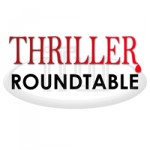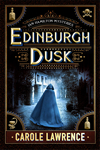

July 16 – 22: “How do you set up those grand, loud, all-out climaxes?”
 Post ThrillerFest we’re discussing those grand climaxes so often associated with thrillers. We’re joined by ITW Members Martin Roy Hill, Alan Jacobson, Sandra Block, Robert J. Stava, Sarah Simpson, J.H. Bográn and Carole Lawrence as they answer the question: “Thrillers are known for their grand, loud, all-out climaxes. How do you set them up?” Scroll down to the “comments” section to follow along. You won’t be sorry!
Post ThrillerFest we’re discussing those grand climaxes so often associated with thrillers. We’re joined by ITW Members Martin Roy Hill, Alan Jacobson, Sandra Block, Robert J. Stava, Sarah Simpson, J.H. Bográn and Carole Lawrence as they answer the question: “Thrillers are known for their grand, loud, all-out climaxes. How do you set them up?” Scroll down to the “comments” section to follow along. You won’t be sorry!
 Carole Lawrence (C. E. Lawrence, Carole Bugge) is the author of eleven published novels, award-winning plays, musicals, poetry and short fiction. Her most recent novel is the historical thriller Edinburgh Dusk, the second book in the Ian Hamilton Mysteries series. Her “Silent” series (Silent Screams and its sequels) follows NYPD profiler Lee Campbell in his pursuit of serial killers. Her plays and musicals have been performed internationally – including an original Sherlock Holmes musical. Her most recent musical is Murder on Bond Street, based on a true story. A self-described science geek, she likes to hunt wild mushrooms.
Carole Lawrence (C. E. Lawrence, Carole Bugge) is the author of eleven published novels, award-winning plays, musicals, poetry and short fiction. Her most recent novel is the historical thriller Edinburgh Dusk, the second book in the Ian Hamilton Mysteries series. Her “Silent” series (Silent Screams and its sequels) follows NYPD profiler Lee Campbell in his pursuit of serial killers. Her plays and musicals have been performed internationally – including an original Sherlock Holmes musical. Her most recent musical is Murder on Bond Street, based on a true story. A self-described science geek, she likes to hunt wild mushrooms.
 Alan Jacobson is the award-winning, USA Today bestselling author of a dozen books featuring FBI profiler Karen Vail and the OPSIG Team Black covert ops group. His 20+ years of research and training with the FBI, DEA, ATF, SWAT, Scotland Yard, and the US military infuse his books with verisimilitude. His novels have been optioned by Hollywood and both series have been raved about by federal agents, police captains, FBI profilers, and Navy SEALs.
Alan Jacobson is the award-winning, USA Today bestselling author of a dozen books featuring FBI profiler Karen Vail and the OPSIG Team Black covert ops group. His 20+ years of research and training with the FBI, DEA, ATF, SWAT, Scotland Yard, and the US military infuse his books with verisimilitude. His novels have been optioned by Hollywood and both series have been raved about by federal agents, police captains, FBI profilers, and Navy SEALs.
 Sandra Block graduated from college at Harvard, then returned to her native land of Buffalo, New York for medical training and never left. She is a practicing neurologist and proud Sabres fan, and lives at home with her husband, two children, and impetuous yellow lab. Little Black Lies is her debut, a finalist in the International Thriller Awards, and The Girl Without a Name and The Secret Room are the other books in the Zoe Goldman series. Her latest stand-alone novel What Happened That Night comes out in June 2018.
Sandra Block graduated from college at Harvard, then returned to her native land of Buffalo, New York for medical training and never left. She is a practicing neurologist and proud Sabres fan, and lives at home with her husband, two children, and impetuous yellow lab. Little Black Lies is her debut, a finalist in the International Thriller Awards, and The Girl Without a Name and The Secret Room are the other books in the Zoe Goldman series. Her latest stand-alone novel What Happened That Night comes out in June 2018.
 A veteran of the NYC advertising business, Robert J. Stava is a horror & science fiction writer living in the Hudson Valley, apparently not far from the village where many of his stories are set: Wyvern Falls. His last novel, Nightmare From World’s End, was published by Severed Press in 2016 and his next science fiction-horror novel, Neptune’s Reckoning, set in Montauk, is due out the end of 2018. His short stories have appeared in various anthologies over the last several years and he has also authored one YA novella, The Devil’s Engine, published by Muzzleland Press. He’s also a musician, artist and historian. His non-fiction book Combat Recon was published in hardcover by Schiffer Publishing in 2008, encompassing the history and photography of his great uncle John Stava, a combat photographer with the 5th Air Force in the SW Pacific during WWII.
A veteran of the NYC advertising business, Robert J. Stava is a horror & science fiction writer living in the Hudson Valley, apparently not far from the village where many of his stories are set: Wyvern Falls. His last novel, Nightmare From World’s End, was published by Severed Press in 2016 and his next science fiction-horror novel, Neptune’s Reckoning, set in Montauk, is due out the end of 2018. His short stories have appeared in various anthologies over the last several years and he has also authored one YA novella, The Devil’s Engine, published by Muzzleland Press. He’s also a musician, artist and historian. His non-fiction book Combat Recon was published in hardcover by Schiffer Publishing in 2008, encompassing the history and photography of his great uncle John Stava, a combat photographer with the 5th Air Force in the SW Pacific during WWII.
 Martin Roy Hill is the author of the Linus Schag, NCIS, thrillers, the Peter Brandt thrillers, and the award-winning short story collection DUTY, and EDEN: A Sci-Fi Novella. Martin’s short stories have appeared in Alfred Hitchcock Mystery Magazine, ALT HIST: The Journal of Historical Fiction and Alternative History, Mystery Weekly Magazine, Crimson Streets, Nebula Rift, Devolution Z, and others. A former national award-winning investigative journalist, Martin is now a military analyst.
Martin Roy Hill is the author of the Linus Schag, NCIS, thrillers, the Peter Brandt thrillers, and the award-winning short story collection DUTY, and EDEN: A Sci-Fi Novella. Martin’s short stories have appeared in Alfred Hitchcock Mystery Magazine, ALT HIST: The Journal of Historical Fiction and Alternative History, Mystery Weekly Magazine, Crimson Streets, Nebula Rift, Devolution Z, and others. A former national award-winning investigative journalist, Martin is now a military analyst.
 Always a deep thinking child, Sarah Simpson supposed that one day – she’d become a writer. So many hours consumed by reading, lost in the fantasy worlds of Enid Blyton. Always a people watcher, wondering what is ensuing behind the eyes. But as is often the case, life gripped her hand, and led her along a different path. She graduated first with a business degree and then with a psychology degree. After completing post-graduate studies, Sarah worked as a therapist within the varied field of mental health. This path has gifted her an invaluable understanding of life and of people. Now a writer; she could never have been without these experiences. She wanted to write about life and as with her debut novel, HER GREATEST MISTAKE – perhaps travel the darker aspects of life and relationships.
Always a deep thinking child, Sarah Simpson supposed that one day – she’d become a writer. So many hours consumed by reading, lost in the fantasy worlds of Enid Blyton. Always a people watcher, wondering what is ensuing behind the eyes. But as is often the case, life gripped her hand, and led her along a different path. She graduated first with a business degree and then with a psychology degree. After completing post-graduate studies, Sarah worked as a therapist within the varied field of mental health. This path has gifted her an invaluable understanding of life and of people. Now a writer; she could never have been without these experiences. She wanted to write about life and as with her debut novel, HER GREATEST MISTAKE – perhaps travel the darker aspects of life and relationships.
 J. H. Bográn, is a bilingual author of novels, short stories, and screenplays. In addition, he contributes columns for several notable publications, including Yale Global, The Big Thrill, and TopShelf Magazine. He works at Habitat for Humanity Honduras, and as a part-time college professor of Writing, Spanish, and English as a foreign language. Follow him on Twitter (@jhbogran).
J. H. Bográn, is a bilingual author of novels, short stories, and screenplays. In addition, he contributes columns for several notable publications, including Yale Global, The Big Thrill, and TopShelf Magazine. He works at Habitat for Humanity Honduras, and as a part-time college professor of Writing, Spanish, and English as a foreign language. Follow him on Twitter (@jhbogran).
- LAST GIRL MISSING with K.L. Murphy - July 25, 2024
- CHILD OF DUST with Yigal Zur - July 25, 2024
- THE RAVENWOOD CONSPIRACY with Michael Siverling - July 19, 2024
